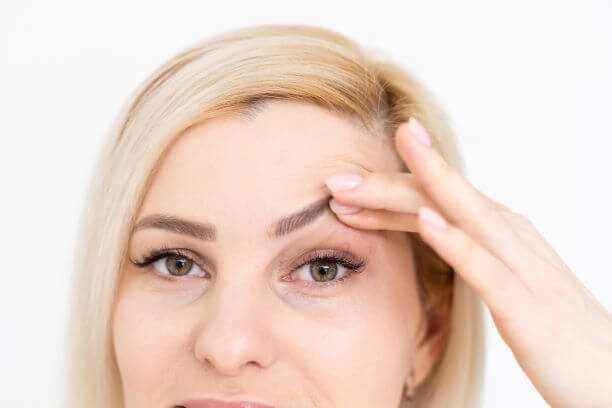When it comes to turning back the clock, Botox is one of the most reliable solutions to minimize fine lines and wrinkles on the face to keep you looking your best. Like any other treatment, Botox does have some potential side effects. According to Dr. Jennifer Holman of U.S. Dermatology Partners’ Center for Aesthetic and Laser Medicine in Tyler, Texas, “In most cases, Botox is a perfectly safe treatment that delivers exceptional results, but there are always potential risks associated with any treatment. Droopy eyelid is one of the potential side effects related to Botox treatment. While this is a relatively rare occurrence, it’s important for people to understand the potential risks before they move forward with any cosmetic dermatology treatments.” Keep reading to learn more about how Botox can cause droopy eyelids and what you should do to treat this condition.
What is Botox?
Before discussing the potentially adverse effects of Botox, it’s important to understand just what this cosmetic dermatology treatment is. Botox is a controlled injection of the botulinum toxin type A. It was originally developed to limit muscle movements for people with spasms, bladder control issues, excessive sweating, chronic migraines, and a range of other conditions. During trials for the product, researchers noticed an unintended positive outcome. The injection also limited the unconscious muscle movements that cause the development of fine lines and wrinkles.
Since this discovery, millions of people have received Botox Cosmetic injections every year. Because every person’s face moves differently, it’s up to the dermatologist to determine the precise muscle groups to target. That’s why it’s so important to find a skilled, board-certified dermatologist to perform your Botox treatment. Dr. Holman says, “Side effects like drooping eyelids are most likely to occur when Botox is administered by an inexperienced practitioner, so make sure you’re working with a professional to ensure risks are minimized and results are maximized.”
What Causes Droopy Eyelids After Botox Treatment?
Botox can cause a range of side effects, including droopy eyelids. Botox works by freezing specific muscle groups to reduce unconscious movements and minimize the development of fine lines and wrinkles. Unfortunately, there can be some adverse effects if Botox is not administered correctly. Ptosis, the medical name for droopy eyelids, is a common, adverse effect that occurs after Botox when the injected treatment spreads into the areas around the targeted injection site. Specifically, injections on the forehead or between the eyes may spread into the eyebrows and cause the brow to lower, causing a droopy eyelid.
In most cases, droopy eyelid occurs between one and three weeks after treatment, and patients typically experience this adverse effect for just a few weeks. According to Dr. Holman, “It’s important to remember that, like Botox treatments, a drooping eyelid is usually temporary. The effect will wear off after a while. However, if the eyelid droop starts to impede your vision or cause other issues, there are options for treatment that you can review with your dermatologist.”
How are Droopy Eyelids Treated?
According to Dr. Holman, “The vast majority of patients who experience droopy eyelids after Botox treatment will not require any treatment. The side effect is usually mild and temporary. However, if the drooping eyelid inhibits vision or doesn’t begin to improve, there are some options available to address the concern. Even if you don’t need intervention, you should let your dermatologist know about your response, so they can adjust any future Botox treatments to further minimize your risk for side effects like ptosis.”
Some of the treatments your dermatologist may recommend to address droopy eyelid following Botox include:
- At-home interventions – for those with very minimal eyelid drooping, massaging the area around the eyes with your fingertips or the back of an electric toothbrush or exercising the muscles by keeping the eyes open and then closed can help to reduce the appearance of eyelid droop.
- Eye drops – medicated apraclonidine eye drops may help to stimulate the receptors that tell eye muscles to contract. These drops have been proven to raise the eyelid up to two millimeters.
- Electrical stimulation – in some cases, stimulating the droopy eyelid can decrease the effects and shorten the amount of time your eyelid continues drooping. There are electrical stimulus treatments available to help activate the muscle groups.
Take Steps to Prevent Eyelid Droop
According to Dr. Holman, “It is always best to prevent eyelid droop before it ever happens. The number one thing you should do is work with a qualified professional to administer your Botox injections. I know it might seem convenient to stop in at the neighborhood medi-spa, but when you receive Botox from these less qualified professionals, you run a greater risk of experiencing adverse effects of Botox. Additionally, you need to make sure to tell your doctor if you’ve taken any muscle relaxers, blood thinners, sleep aids, or allergy medicines in the past few months. If you’ve had any adverse responses to any of the ingredients of Botox, to latex, or you have generally sensitive skin, Botox may not be the best treatment to meet your needs. Finally, if you’ve been diagnosed with Bell’s Palsy or had a traumatic facial injury in the past, you may need to make sure your dermatologist knows about this history before you begin Botox treatment.”
Are There Other Side Effects of Botox?
In addition to droopy eyelids, there are numerous adverse effects linked to Botox treatments, so make sure you talk through all potential symptoms and your risk before you begin your Botox treatment. Most side effects of Botox injections are mild and temporary.
Some of the most common side effects of Botox include:
- Mild bruising or inflammation at the injection site
- Dry eyes
- Dry mouth
- Fever
- Headache
- Upper respiratory infection
You should also let your dermatologist know right away if you have any of these side effects that last longer than expected, cause health or cosmetic concerns, or symptoms get worse, you should get in touch with your dermatologist. You should also get in touch with your dermatologist right away if you experience any of the following rare side effects of Botox treatment:
- Open sores in the cornea (clear coating over the eye)
- Blurred vision
- Redness, watery, or painful eyes
- Problems breathing, speaking, or swallowing
- Signs of allergic response
Visit U.S. Dermatology Partners to Find Out More
If you’re experiencing adverse effects of Botox or you’re interested in learning more about treatments to reduce the appearance of fine lines and wrinkles, the skilled dermatologists at U.S. Dermatology Partners are here for you. Get started today by filling out our online scheduling form. Once a local practice hears from you, we’ll be in touch to finalize the details of your visit.
Find a location near me
or


